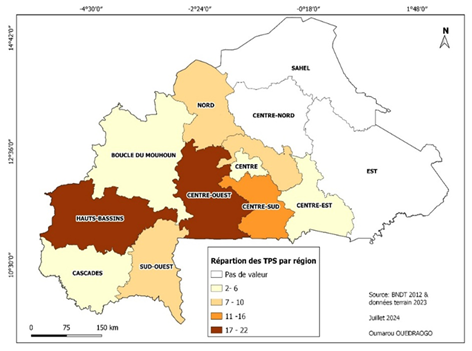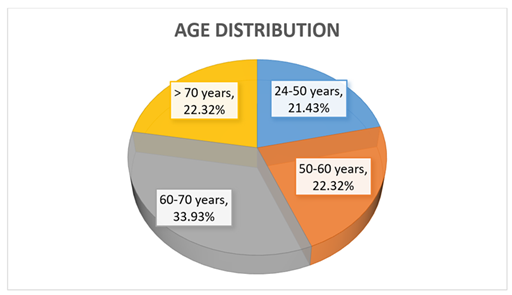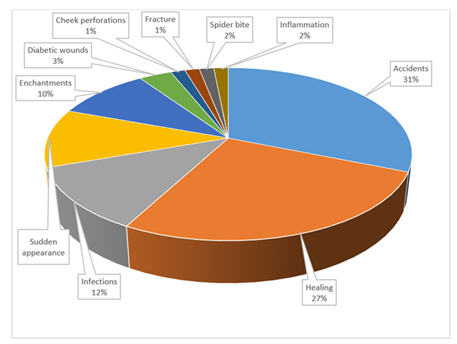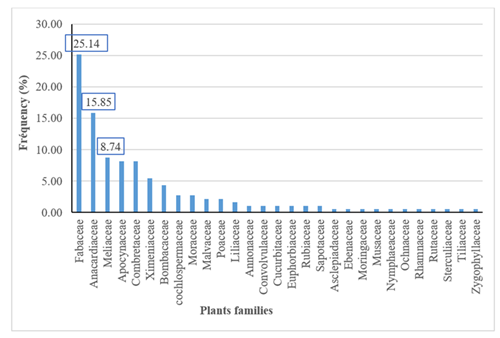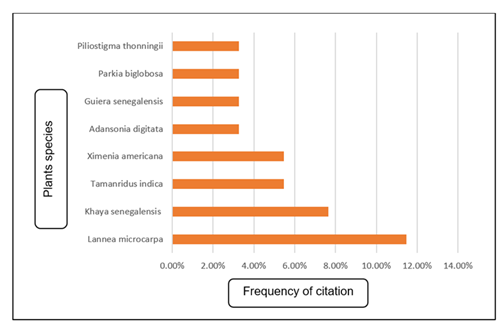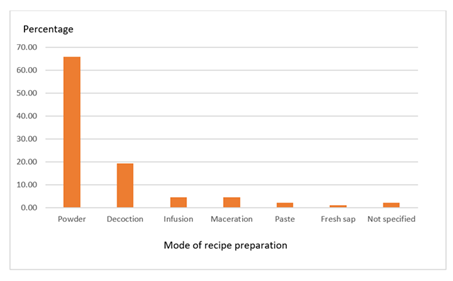Ethnobotanical Survey on Plants Used in the Treatment of Wounds by Traditional Health Practitioners in Burkina Faso
Safiatou Traoré1,2*, Hermine Diawara/Zimé1,3, Salfo Ouédraogo1,2, Souleymane Compaoré2, Geoffroy Wendpanga Gasbeogo1, Hyacinthe Wendégoudi Bonkoungou4, Rasmané Semdé1
1Laboratory of Drug Development, Centre for Training, Research and Expertise in Drug Sciences, Doctoral School of Sciences and Health, Joseph Ki-Zerbo University, Ouagadougou, Burkina Faso
2Research Institute of Health Sciences: Institut de Recherche en Sciences de la Santé, Ouagadougou, Burkina Faso
3University Hospital Center Yalgado Ouédraogo, Ouagadougou, Burkina Faso
4Directorate of Traditional and Alternative Medicine, Ouagadougou, Burkina Faso
*Corresponding Authors: Safiatou Traore, Laboratory of Drug Development, Centre for Training, Research and Expertise in Drug Sciences, Doctoral School of Sciences and Health, Joseph Ki-Zerbo University, Ouagadougou, Burkina Faso.
Received: 24 July 2025; Accepted: 19 August 2025; Published: 25 August 2025
Article Information
Citation: Safiatou Traoré, Hermine Diawara/Zimé, Salfo Ouédraogo, Souleymane Compaoré, Geoffroy Wendpanga Gasbeogo, Hyacinthe Wendégoudi Bonkoungou, Rasmané Semdé. Ethnobotanical Survey on Plants Used in the Treatment of Wounds by Traditional Health Practitioners in Burkina Faso. International Journal of Plant, Animal and Environmental Sciences. 15 (2025): 132-143.
View / Download Pdf Share at FacebookAbstract
Chronic wounds constitute a real problem in the sphere of care and its management requires the mobilization of enormous financial resources from the patient in low- and middle-income countries. In Burkina Faso, traditional medicine has remained the most popular health care system. However, very little data exists on the plants used specifically in the management of wounds by THP. This study aimed to contribute to the knowledge of plants with healing activities used by traditional health practitioners in Burkina Faso. It was a descriptive cross-sectional study from March to December 2023 among traditional health practitioners specializing in wound care in Burkina Faso through a direct interview with a quiz. One hundred and twelve (112) traditional health practitioners (THP) were interviewed, aged between 24 and 87 years, with an average of 58.71 +/- 12.07 years. The number of years of practice in the profession varied between 02 and 67 years, with an average of 25.49 ± 14.12 years. A high concentration of THP wound specialists was recorded in the regions of Hauts Bassins (21.43%), Center West (20.54%), and Center South (14.29%). Men were the most represented (88.39%). Seventy (70) plant species were identified and Lannea microcarpa Engl. & K. Krause (11.41%), Khaya senegalensis (Desr) A. Juss. (7.61%), Tamarindus indica L. (5.43%), and Ximenia americana L. (5.43%) were the most used species for wound treatment. These results could be a database for research and will make it possible to make Improved Traditional Medicines available to populations at a lower cost.
Keywords
Plants; Healing; Traditional health practitioners; Burkina Faso
Plants articles; Healing articles; Traditional health practitioners articles; Burkina Faso articles
Article Details
1. Introduction
The human body is entirely covered by skin, making it the largest organ of the body. It plays several roles, including a role as a barrier with the external environment, maintaining hemostasis, and a sensory role [1,2]. A break in the skin leads to the appearance of a wound which, depending on the healing time, can be acute or chronic [3]. Chronic wounds constitute a real problem in the sphere of care because they can lead to cancer at the site organ [4]. Despite the existence of modern treatments, they remain one of the main causes of consultation and hospitalization in the world [5]. Their main objective is to ensure rapid closure of the wound and satisfactory healing from both a functional and aesthetic point of view [3]. It requires the mobilization of enormous financial resources from the patient, which leads, in low- and middle-income countries, to an interruption of treatment during care. Approximately $25 billion is spent on chronic wound care worldwide [2].
In Burkina Faso, wounds occupied fifth place among the reasons for external consultation in health facilities, with a rate of around 2%, in 2021 [6]. If the rate (2%) of reasons for external consultation for wounds seems low, the majority of cases of trauma (wounds, burns) in rural areas escape the coverage of health structures because the populations make little use of them. Indeed, the problem of access to health care remains a major challenge in countries with limited resources. The use of traditional medicine remains very widespread in West Africa. Since time immemorial, medicinal plants have been the mainstay of conservative medicine in many cultures around the world, particularly in African society. Indigenous knowledge about the healing properties of plants has been passed down from generation to generation and today serves as the basis for research into herbal medicines [7].
Many people consider herbal medicines, traditional treatments, and traditional practitioners to be the main or even only source of health care. These people place particular trust in it, given the proximity of care, cultural recognition, and financial accessibility [8]. So, the World Health Organization (WHO) estimates that 80% of people in the world use traditional medicine [9].
The financial affordability of most traditional medicines makes them all the more attractive at a time when healthcare costs are exploding and austerity is almost universal. Traditional medicine also appears to be a means of dealing with the inexorable rise of chronic non-communicable diseases [8]. In Burkina Faso, and for many years, traditional medicine has remained the most popular health care system because it is better integrated into the socio-cultural realities of the populations [10].
Numerous studies have been conducted on medicinal plants in Burkina Faso. However, very little data exists on the plants used specifically in the management of wounds in Burkina Faso by THP. We proposed to carry out an ethnobotanical and ethno-pharmacological study of plants with healing properties in Burkina Faso.
2. Materials and Methods
2.1 Area of study
Our study was carried out in Burkina Faso, which is made up of thirteen (13) health regions. It concerned ten (10) health regions, namely the Center, Center East, Center West, Center South, Central Plateau, North, Boucle du Mouhoun, Cascades, South West, and Hauts-Bassins regions. Three (03) health regions have not been visited due to the security risk. It is the northern center, the Eastern, and the Sahelian regions.
2.2 Data collection
This was a descriptive cross-sectional study carried out among traditional health practitioners specializing in wound care in Burkina Faso. The survey and data analysis took place from March 2023 to December 2023 in close collaboration with the Directorate of Traditional and Alternative Medicine of Burkina Faso. The main objective of this study was to collect information on medicinal plants and medical practices in the management of wounds by THP in Burkina Faso.
THP specialists in wound care from the ten (10) health regions of the country constituted the study population. Before the study, authorization was obtained from the Directorate of Traditional and Alternative Medicine, which facilitated contact through the focal points of the different THP associations. These focal points were responsible for identifying wound care specialists and scheduling interview appointments before the arrival of the interviewer. They also served as a guide to take this person to the THP, and for this purpose, financial compensation was offered in return for the time and cost linked to their travel. Informed consent was obtained from the THP before the start of the interview, which was carried out based on a direct questionnaire including requests for socio-demographic information (Age, gender, ethnicity, level of education, geographical location, religion). Information on the THP profession and medical practices in the management of wounds, including recipes used, local names of plants used, plant parts used, as well as methods of preparation. To facilitate the interview, the questionnaire developed in French was administered in the language of choice of the THP with the assistance of the focal point if necessary.
An identification number was assigned to each traditional health practitioner surveyed to preserve anonymity. The plants cited by the THP in a local name were identified by a botanical technician from the Directorate of Traditional and Alternative Medicine.
For data processing and analysis, Excel 2013 software in version 2 and STATA in version 12 were used. Citation frequency (CF) values ??were determined to establish consensus on plant species that are frequently used to treat wounds according to the following formula:

3. Results
3.1 Geographical distribution of traditional health practitioners (THP)
A total of 10 regions of Burkina Faso were visited as part of this study. The initial objective, which was to cover the entire territory (meaning thirteen regions), could not be achieved due to the security context having prevented access to the Centre-North, East, and Sahel regions, which are the areas with the highest security challenge. So, one hundred and twelve (112) traditional health practitioners specializing in wounds were registered. The highest densities of THPS were registered in the regions of Hauts-Bassins (21.43%) and Central West (20.54%). No data was recorded for the Centre-North, East, and Sahel regions. Their geographical distribution is given by Figure 1.
3.2 Distribution by age group
The THP had an age between 24 years and 87 years, an average age of 58.71 years with a standard deviation of 12.072 (Figure 2). The age group over 50 years represented 78.57% of THP.
The majority of THP were men, i.e., 99 men for 13 women, which represents a rate of 88.39% of THP or a sex ratio of 0.12. This low ratio reflects a low involvement of women in traditional medicine in general and, more particularly, in the management of wounds.
3.3 Repartition by ethnic group
A total of fourteen (14) ethnic groups were represented in the population of the THP surveyed (Table 1). Eighty (80) THP belonged to the Mossi ethnic group, which means a percentage of 71.43%. However, we did not have access to THP residing in the Sahel, East, and North-Central regions.
|
N° |
Ethnie |
Nombre |
Pourcentage (%) |
|
1 |
Mossi |
80 |
71,43 |
|
2 |
Gurunsi |
8 |
7,14 |
|
3 |
Dioula |
3 |
2,68 |
|
4 |
Foulbé |
4 |
3,57 |
|
5 |
Karaboro |
3 |
2,68 |
|
6 |
Siamou |
3 |
2,68 |
|
7 |
Birifor |
2 |
1,79 |
|
8 |
Samo |
2 |
1,79 |
|
9 |
Walsé |
2 |
1,79 |
|
10 |
Bobo |
1 |
0,89 |
|
11 |
Dafing |
1 |
0,89 |
|
12 |
Djan |
1 |
0,89 |
|
13 |
Lobi |
1 |
0,89 |
|
14 |
Sénoufo |
1 |
0,89 |
|
TOTAL |
112 |
100,00 |
Table 1: Repartition by ethnic group of THP.
3.4 Distribution by educational level and by source of knowledge
Thirty-four (34) THP out of 112 were educated, which represented 30.35% of the population, and 44.86% had benefited from Koranic instruction. Among educated THP, 2 had reached university level, 14 had reached secondary level, and 18 had reached primary level.
The three main sources of knowledge mentioned by the THP were inheritance (family transmission) (54.55%), initiation by another THP (27.27%), and the gift of nature (revelation) (06.36%).
The average experience was 25.49 years with a standard deviation of 14.12. The variation is between 2 years to 67 years.
Regarding the regulatory status of THP, 26.13% of THP investigated had a practice authorization issued by the competent authority. 38.39% of THP worked full-time, 38.39% combined the practice of traditional ethnomedicine with agricultural activities, and 36.99% of THP combined agricultural and livestock activities.
3.5 Main causes of wounds treated by THP
The wound treated by THP are due mainly to accidents at 31.18%, to burns at 26.62% and infections at 11.79%. secondary causes are sudden apparitions, bewitchments, diabetic wounds, fractures, and spider bites as showed by Figure 3.
3.6 Cited plant families
Seventy (70) species of plants belonging to twenty-nine (29) families were cited (Figure 4). The majority of families, according to frequency of citation, were Fabaceae (25.14%), Anacardiaceae (15.85%), Meliaceae (8.74%), Apocynaceae (8.20%), Combretaceae (8.20%), Ximeniaceae (5.46%), Bombacaceae (4.37%). Other families were cited at a frequency of less than 3% each. The Fabaceae family was the most represented.
3.7 Cited plant species
All sixty (70) plant species listed by the THP have been divided into two categories: the category of frequently cited plant species (citation frequency greater than or equal to 3%) and the category of less frequently cited species (citation frequency less than 3%).
The first category included eight (08) plants out of sixty (70) (Figure 5). Which are in first position Lannea microcarpa Engl. And K. Krause (Anacardiaceae) at 11.47%. It was followed by Khaya senegalensis (Desr) A. Juss. (Meliaceae) at 7.65%, Tamarindus indica L. (Fabaceae) at 5.45%, Ximenia americana L. (Ximeniaceae) at 5.45%. Adansonia digitata L. (Malvaceae), Guiera senegalensis J.F.Gmel. (Combretaceae), Parkia biglobosa (Jacq.) R. Br. Ex G.D. (Fabaceae) et Piliostigma thonningii (Schum) Milne-R (Fabaceae) were cited at a frequency of 3.27%. These eight plants represent 11.43% of all species cited by the THP.
3.8 Plant parts used by THP for wound management
Eight (08) parts were cited by THP for the preparation of their remedies (Table 2). Trunk bark, roots, and leaves are the parts most used by THP, with rates of 29.74%, 26.67%, and 26.15%, respectively. The other parts were frequently cited less than 10%. It was fruit (or seeds), branches, whole plants, plant pests, fresh sap.
|
Plant drug |
Frequency (%) |
|
Trunk bark |
29,74 |
|
Roots |
26,67 |
|
Leaves |
26,15 |
|
Fruit/Seeds |
7,7 |
|
Branches |
5,64 |
|
Whole plants (herbs) |
2,56 |
|
Plant pests |
1025 |
|
Fresh sap |
0,51 |
|
Total |
100 |
Table 2: Different plant parts used by THP to treat wounds
3.9 Recipe preparation and administration
The remedies prepared by THP are diverse and often comprise several types of preparation. Remedies in powder form are the most widely used (65.91%). The following forms are liquid forms such as decoction (19.32%), infusion (4.55%), maceration (4.55%), paste (2.27%), fresh sap (1.14%). The routes of administration used by THP were cutaneous (95.89%) and oral (4.11%). At the end of treatment, 100% of THP reported not doing any post-treatment follow-up.
Figure 6 presents the mode of preparation of recipe used by THP.
Table 3 summarizes the plant species cited by the THP, as well as their route of administration and method of preparation.
Table 3: Synthesis of plants with healing activity and their mode of use.
4. Discussion
4.1 Geographical distribution of traditional health practitioners (THP)
The highest densities of THPS were registered in the regions of Hauts-Bassins (21.43%) and Central West (20.54%). No data was recorded for the Centre-North, East, and Sahel regions.
This observation could be explained by the fact that populations tend to develop endogenous mechanisms for resolving the ills plaguing their community. Thus, one could easily assume that the THP has specialized in these regions to deal with the high number of plagues occurring in their community. Indeed, according to the statistical directory of the Ministry of Health and Public Hygiene (MSHP) (2021), the regions recording the highest frequencies of wounds were, in descending order, the central regions (105 421 cases), Hauts-Bassins (76 872) and Center-Ouest (59 737) [6]. The central region, which is a highly urbanized region, did not have a high THP population because, due to the accessibility of modern health care, the level of education and the standard of living in general, the population tended to have high attendance at health facilities.
4.2 Distribution by age group
The age group over 50 represented 78.57% of THP and this can be explained by the fact that the African conception of traditional medicine admits that it is the wise, that is to say, the elderly, who hold the traditional knowledge of treating diseases. Also, learning traditional medicine takes time and requires a certain maturity because it relies exclusively on lived experiences and knowledge passed down from generation to generation [11]. Poyodi et al. [4], Bio et al. [11] reported similar results.
However, this concentration of knowledge among older people constitutes a risk of progressive loss of knowledge if they do not transfer knowledge before their disappearance.
The predominance of men in THP (88.39% of THP) interviewed reflects a low involvement of women in traditional medicine in general and, more particularly, in the management of wounds. Bio et al. [11] in Benin reported a sex ratio (F/M) of 0.11, which is close to our result [4]. The low proportion of women in the knowledge and practice of traditional medicine can be explained by the primacy given to men in matters of property and inheritance rights in the majority of African societies. It can also be explained by the fact that women (girls) are more often busy with household chores and are separated from their parents for marriage before the appropriate age for traditional medicine knowledge transmission.
4.3 Repartition by ethnic group
The predominance of the Mossi ethnic group in the THP interviewed (71,34%) is consistent with the general population of Burkina Faso. Indeed, in Burkina Faso, around sixty ethnic groups coexist, with a majority of Mossi at 57% [12]. However, we did not have access to THP residing in the Sahel, East, and North-Central regions.
4.4 Distribution by educational level and by source of knowledge
In the THP population, 30.35% of the population were educated, and 44.86% had benefited from Koranic instruction. The poor level of education of THP surveyed could be linked to the low rate of schooling in the general population of Burkina Faso [13].
The knowledge of THP were mainly given by inheritance (family transmission). It is the proof that traditional ethnomedicine is a social science and its contents remain a family heritage such as explained by Tamboura et al. [14]. Also, knowledge of a recipe in traditional medicine is, above all, a family secret which is transmitted from generation to generation through customs and oral tradition [15]. Kola et al. [4] also showed a predominance of family transmission of knowledge with a proportion of 85.96% in Togo [4].
The average experience is relatively high (25.49 years) and is linked to the high proportion of elderly THP who were surveyed. This could help to give some reliability to the information collected. Indeed, according to BENLAMDINI and al. (2014), knowledge of the uses of medicinal plants and their properties is generally acquired following long experience accumulated and passed down from one generation to another [16]. The average experience obtained is close to that of JAZY et al. [17], who were 25.76 years.
Regarding the regulatory status of THP, 26.13% of THP investigated had a practice authorization issued by the competent authority. 38.39% of THP worked full-time, 38.39% combined the practice of traditional ethnomedicine with agricultural activities, and 36.99% of THP combined agricultural and livestock activities.
4.5 Cited plant families
The Fabaceae family was the most represented (25.14%). This high representativeness could be justified by the fact that it is considered to be the family that includes the largest number of medicinal plants, with a representativeness of more than 25%. Generally speaking, it is the 3rd largest family with the greatest number of plant species [18]. In fact, according to the phyllogenetic classification (APG IV), it groups the subfamilies Fabaceae-Mimosoideae, Fabaceae-Caesalpinoideae et de Fabaceae-Papilionoideae in a single family. This result corroborates those of Ramde et al. [19], who found a predominance of Fabaceae with a frequency of 26% [19].
4.6 Cited plant species
Among the plant species listed by the THP there is the category of frequently cited plant species (citation frequency greater than or equal to 3%) and the category of less frequently cited species (citation frequency less than 3%).
The first category included eight (08) plants out of sixty (70). These results were similar to those reported by Kola et al. [4], which had recorded around ten frequently cited species out of 70 listed for the management of tumor wounds in Togo [4].
Lannea microcarpa Engl. And K. Krause were the species cited in first position (Anacardiaceae) at 11.47%, followed by Khaya senegalensis (Desr) A. Juss. (Meliaceae) at 7.65%, Tamarindus indica L. (Fabaceae) at 5.45%, Ximenia americana L. (Ximeniaceae) at 5.45%. Adansonia digitata L. (Malvaceae), Guiera senegalensis J.F.Gmel. (Combretaceae), Parkia biglobosa (Jacq.) R. Br. Ex G.D. (Fabaceae) et Piliostigma thonningii (Schum) Milne-R (Fabaceae) were cited at a frequency of 3.27%.
Many studies have reported the traditional use of L. microcarpa by THP, particularly in West Africa, in the treatment of wounds [20,21]. Goudégnon et al. [20] reported that the bark was used in the form of macerate or infusion as a dressing on wounds [20]. Other studies have highlighted the antimicrobial, antioxidant, and anti-inflammatory properties of L. micracarpa, which are beneficial for wound healing [22-24]. Indeed, wound healing being a multifactorial process involving antioxidant, anti-inflammatory, and/or anti-bacterial activity, most plants would seem to exhibit these properties. The same study showed that phytoconstituents such as steroïds, glycosides, tannins, saponines, triterpenes, alcaloïdes, and flavonoïdes were present in the extract of the trunk bark of Lannea microcarpa and would be responsible for the anti-inflammatory properties [25].
Khaya senegalensis (Meliaceae) was the second most cited plant by THP, with a frequency of 7.61%. Our results are in line with those of Kola et al. [4], and Soha et al. [26], who reported the use of leaves and bark of this plant by THP for wound treatment [4,26]. This activity was demonstrated in vivo on rats by Attah et al. (2016) and appears to be mediated by the formation of granulation tissue that promotes wound healing [27]. The anti-free radical and antibacterial properties of K. senegalensis trunk bark were also demonstrated by Koudoro et al. [28], by Lompo et al. [25], and Kawo et al. [29].
Other plant species cited by THP, such as Tamarindus indica L. (5.43%), Ximenia americana L. (5.43%), Adansonia digitata L. (3.26%), Guiera senegalensis J.F. Gmel. (3.26%), Parkia biglobosa (Jacq.) R. Br. Ex G.D. (3.26%) and Philiostigma thonningii (Schum) Milne-R (3.26%) have all been cited in studies as possessing healing properties [4,30,31].
4.7 Plant parts used by THP for wound management
Eight (08) parts were cited by THP for the preparation of their remedies. Trunk bark, roots and leaves was the preferred part. The study carried out by Zerbo et al. [30] revealed that leaves were used most often (31%), followed by trunk bark (25%), roots (23%), and finally fruit (10%) [4]. The same was true of Nadembega et al. [31], who reported the trio of leaves, bark, and roots as the plant parts most commonly used in the composition of remedies, with 38.4%, 30%, and 29.5%, respectively [31]. According to Ngbolua et al. [32], the interest in leaves and bark can be explained by the fact that they are the site par excellence for the biosynthesis and even storage of secondary metabolites responsible for the plant's biological properties [32]. In the case of trunk bark, how it is harvested in some cases poses a threat to the survival of the species. Sustainable exploitation, valorization, and conservation strategies must be envisaged to promote and perpetuate the use of plants for medicinal purposes.
4.8 Recipe preparation and administration
The remedies given by the THP were in majority the powder form, followed by liquid forms like decoction and infusion. The predominance of powder is mainly due to its form, which is better suited to remaining in prolonged contact with the wound, which is necessary to obtain the therapeutic effect. Powder is also a dry form that keeps much longer than the liquid form. However, the effect of powder depends on the size of the particles it contains; so finer the powder is, the more effective it is. Muhammed and Salih [33] have demonstrated that the powder's large particles act as a foreign body and prevent the approximation of wound edges by triggering a chronic inflammatory reaction that delays healing [33]. As for the decoction, it is said to gather the most active ingredients and to attenuate or even cancel out the toxic effects of certain recipes. Its use, followed by the application of powder, is explained by the need to clean the wound. Our results corroborate those found by Inngjerdingen et al. [34], who indicated that the most common treatment methods were a decoction in a wash, followed by the application of a plant powder or by applying a plant powder directly to the wound [34].
At the end of treatment, 100% of THP reported not doing any post-treatment follow-up. Thus, most of them considered that their treatment was without side effects, whereas this could be due to a lack of reporting of possible side effects. Ouoba et al. [35], showed that 14.7% herbal medicines could be the subject of an adverse event [35]. This situation highlights the need to strengthen pharmacovigilance of traditional medicine products to guarantee the safe use of herbal medicines [36].
5. Conclusion
In Burkina Faso, traditional health practitioners (THP) actively participate in the treatment of wounds using plants. This survey was conducted to deepen and perpetuate knowledge on plants used in the treatment of wounds. It allowed to identification of 70 plant species belonging to 64 genera and 29 families according to the APG classification. Among these species, some were cited in previous studies as having healing properties. It is about Lannea microcarpa Engl. And K. Krause and Khaya senegalensis (Desr) A. Juss., which are the species most used by THP in our study. Aerial organs such as bark and leaves were favored, and powder is the most used galenic form. However, none of the THP interviewed mentioned post-treatment follow-up actions for their patient. This highlights the matter of insufficient vigilance of traditional medicine products. To achieve the goal of providing everyone with access to quality care, data from traditional medicine can be used to develop pharmaceutical forms whose quality, efficacy, and safety of use will be guaranteed.
6. Declarations
Ethics approval and consent to participate
The Directorate of Traditional and Alternative Medicine of Burkina Faso assessed the proposal and tools for the study and certified that the study was performed without any risk for THP. Prior informed consent to being interviewed and for the work to be published was granted by all the interviewees. Participants provided verbal consent before taking part in interviews. Additionally, they consented to the use of the collected data for publication.
Competing interests: The authors declare that they have no competing interests
Authors’ contributions: ST ensure the design, methodology, data collection, formal analysis, writing, original draft preparation of this manuscript. HDZ ensure the design, methodology, data collection, formal analysis, writing, original draft preparation. SO ensure the design, methodology, supervision, validation, review of this manuscript. SC ensure original draft preparation, review of this manuscript. GG ensure the writing, original draft preparation. HWB ensure data collection and analysis. RS ensure the design, methodology, supervision, validation and review of this manuscript.
Acknowledgements: We are deeply graceful to Dr Nadambega Pascal, and Mister Somé Remi above membership of Directorate of Traditional and Alternative Medicine of Burkina Faso, and Mister KOTE Blami as data analyser; we also acknowledge the traditional health practitioners’ communities for their participation to this study and we are gracefull to the Higher Education Support Project or “Projet d’Appui à l’Enseignement Superieur” (PAES) wich enable data collection from traditional health practitioners and its analysis.
References
- Isabelle PIEDADE. Le systeme tegumentaire (2014): 1-25.
- Mhlongo F, Cordero-Maldonado ML, Crawford AD, et al. Evaluation of the wound healing properties of South African medicinal plants using zebrafish and in vitro bioassays. J Ethnopharmacol [Internet] 286 (2022): 114867.
- Singer AJ. Cutaneous Wound Healing. N Engl J Med 341 (1999): 738-46.
- Kola P, Metowogo K, Kantati YT, et al. Ethnopharmacological Survey on Medicinal Plants Used by Traditional Healers in Central and Kara Regions of Togo for Antitumor and Chronic Wound Healing Effects. Evidence-based Complement Altern Med (2020).
- Agale SV. Chronic Leg Ulcers: Epidemiology, Aetiopathogenesis, and Management. Ulcers (2013): 1-9.
- Annuaire statistique 2021 (2022).
- Singh S, Singh DB, Singh S, et al. Exploring Medicinal Plant Legacy for Drug Discovery in Post-genomic Era. Proc Natl Acad Sci India Sect B - Biol Sci [Internet] 89 (2019): 1141-51.
- Organisation Mondiale de la Santé. Stratégie de l’OMS pour la médecine traditionnelle pour 2014-2023. Organ Mond la Santé [Internet] 72 (2013).
- Santé OOA de la. Pharmacopée de l’Afrique de l’Ouest (2013).
- Guinko S. Les Plantes Et La Medecine Traditionnelle Au Burkina Faso. Berichte des Sonderforschungsbereichs 268, Bd 1, Frankfurt a M (1993): 47-53.
- Bio A, Toyi SSM, Yoka J, et al. Contribution aux connaissances des principales plantes antihypertensives utilisées en médecine traditionnelle à Bassila (Bénin, Afrique de l’Ouest) 17 (2015): 8-18.
- Loada A. Les Burkinabè sont fortement attachés à leur identité nationale (2023): 1-9.
- Zongo E, Meda RNT, Kam SE, et al. Ethnobotanical study of medicinal plants used for viral hepatitis treatment in Hauts-Bassins areas of Burkina Faso. World J Pharm Pharm Sci [Internet] 10 (2021): 76-92.
- Tamboura H, Kaboré H, Yaméogo SM. Ethnomédecine vétérinaire et pharmacopée traditionnelle dans le plateau central du Burkina Faso: Cas de la province du passoré. Biotechnol Agron Soc Environ 2 (1998): 181-91.
- Doumongue T, Koula F doh C, Bledu KM, et al. Etude ethnobotanique des plantes utilisées dans le traitement des troubles du système nerveux dans la médecine traditionnelle au Togo. Int J Biol Chem Sci 17 (2023): 1371-83.
- Benlamdini N, Elhafian M, Rochdi A, et al. Étude floristique et ethnobotanique de la flore médicinale du Haut Atlas oriental (Haute Moulouya). J Appl Biosci 78 (2014): 6771.
- Jazy MA, Karim S, Morou B, et al. Enquête Ethnobotanique Auprès Des Tradipraticiens De Santé Des Régions De Niamey Et Tillabéri Au Niger: Données 2012-2017. Eur Sci Journal, ESJ 13 (2017): 276.
- Asfaw MM, Abebe FB. Traditional medicinal plant species belonging to the Fabaceae family in Ethiopia: A systematic review. Int J Plant Biol 12 (2021).
- Ramde-Tiendrebeogo A, Roger Z, Bassiriki O, et al. Plantes sahéliennes adaptées dans la récupération des terres dégradées et leurs usages pour la santé: cas de la province du Soum au Nord du Burkina Faso. J Anim Plant Sci 41 (2019): 6767-83.
- Goudégnon EOA, Vodouhê FG, Gouwakinnou GN, et al. Ethnic and generational differences in traditional knowledge and cultural importance of Lannea microcarpa Engl. & K. Krause in Benin’s Sudanian savannah. Bois Forets des Trop 4 (2017): 49-59.
- Codo Toafode NM, Oppong Bekoe E, Vissiennon Z, et al. Ethnomedicinal Information on Plants Used for the Treatment of Bone Fractures, Wounds, and Sprains in the Northern Region of the Republic of Benin. Evidence-based Complement Altern Med (2022).
- Picerno P, Mencherini T, Loggia RD, et al. An extract of Lannea microcarpa: composition, activity, and evaluation of cutaneous irritation in cell cultures and reconstituted human epidermis. J Pharm Pharmacol 58 (2010): 981-8.
- Ouattara MB, Bationo JH, Kiendrebeogo M, et al. Evaluation of Acute Toxicity, Antioxidant and Antibacterial Potential of Leaves Extracts from Two Anacardiaceae’s Species: Lannea microcarpa Engl. & K. Krause and Mangifera indica L. J Biosci Med 10 (2022): 125-34.
- Hubert BJ, Adama H, Moussa C, et al. Anti-inflammatory activities of fruit and leaves extract of Lannea microcarpa, England K. Kraus (Anacardiaceae). Int J Pharm Pharm Sci 7 (2015): 177-82.
- Antwi-Adjei M, Owusu G, Ameade EPK. Aqueous extract of Lannea microcarpa attenuates dextran sulphate-induced paw oedema and xylene-induced ear oedema in rodents. Int J Basic Clin Pharmacol 6 (2017): 1048.
- Soha SAS, Dougnon TJ, Ohouko FHO, et al. Activités biologiques et utilisations de Elaeis guineensis (Jacq) et de Khaya senegalensis (Desr) en médecine traditionnelle humaine et vétérinaire. Int J Biol Chem Sci 13 (2019): 525-42.
- Orendu AM, Asala SA, Bedan HI, et al. The effect of the Stem Bark of Khaya senegalensis on Wound Healing in Rabbits: A Preliminary Study. Nov J Med Biol Sci 5 (2016): 1-6.
- Alain KY, Cokou ADP, Diane B, et al. Métabolites secondaires et activités biologiques 23 (2018): 441-50.
- Kawo AH. Studies on the antibacterial activity and chemical constituents of Khaya senegalensis and Ximenia americana leaf extracts. African J Microbiol Res 5 (2011): 4562-8.
- Zerbo P, Millogo-Rasolodimby J, Nacoulma-Ouedraogo OG, et al. Medicinal plants and medical practice in Burkina Faso: A case study on the San people. Bois Forets des Trop 65 (2011): 41-53.
- Nadembega P, Boussim JI, Nikiema JB, et al. Medicinal plants in Baskoure, Kourittenga Province, Burkina Faso: An ethnobotanical study. J Ethnopharmacol [Internet] 133 (2011): 378-95.
- Ngbolua K te N, Inkoto CL, Mongo NL, et al. Étude ethnobotanique et floristique de quelques plantes médicinales commercialisées à Kinshasa, République Démocratique du Congo. Rev Marocaine des Sci Agron Vétérinaires [Internet] 7 (2019): 118-28.
- Muhammed DO, Salih NA. Effect of application of Fenugreek (Trigonella foenum-graecum) on skin wound healing in rabbits. AL-Qadisiya J VetMedSci [Internet] 11 (2012): 86-93.
- Inngjerdingen K, Nergård CS, Diallo D, et al. An ethnopharmacological survey of plants used for wound healing in Dogonland, Mali, West Africa. J Ethnopharmacol 92 (2004): 233-44.
- Ouoba K, Lehmann H, Zongo A, et al. Prevalence of traditional medicine use and adverse events: A population-based cross-sectional survey in Burkina Faso. Eur J Integr Med 51 (2022): 0-3.
- Ouoba K, Lehmann H, Semde R, et al. Revue de la littérature sur la pharmacovigilance des médicaments issus des pharmacopées traditionnelles. Partie I : identification des risques. Ann Pharm Françaises 80 (2022): 646-58.
Article Views: 507
Journal Statistics




Discover More: Recent Articles
Grant Support Articles
© 2016-2025, Copyrights Fortune Journals. All Rights Reserved!

